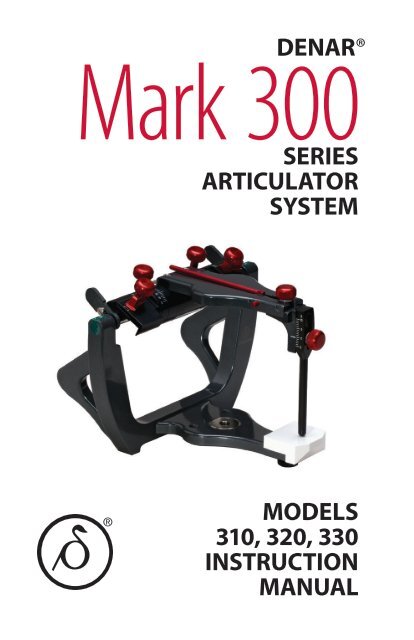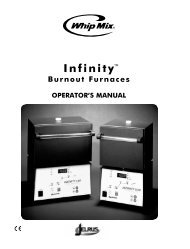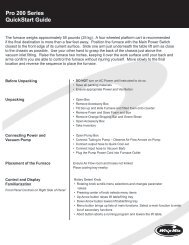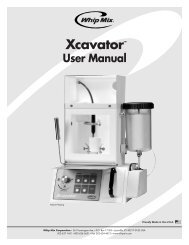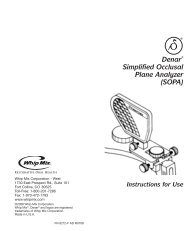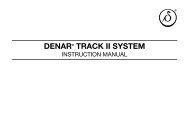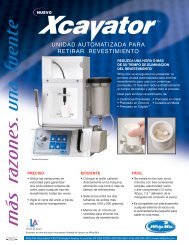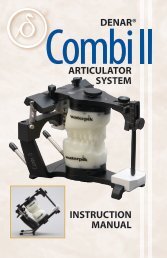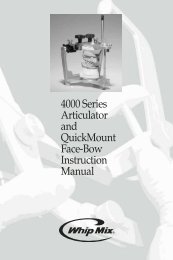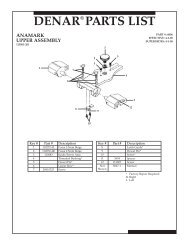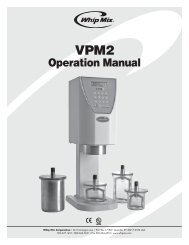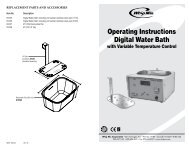Mark 330 Instruction Manual - Whip Mix
Mark 330 Instruction Manual - Whip Mix
Mark 330 Instruction Manual - Whip Mix
Create successful ePaper yourself
Turn your PDF publications into a flip-book with our unique Google optimized e-Paper software.
DENAR®<br />
<strong>Mark</strong> 300<br />
SERIES<br />
ARTICULATOR<br />
SYSTEM<br />
MODELS<br />
310, 320, <strong>330</strong><br />
INSTRUCTION<br />
MANUAL
ACkNOwLEDgEMENTS<br />
<strong>Instruction</strong> <strong>Manual</strong><br />
Practicing dentists, technicians, and educators expressed a need for<br />
an easy to use, yet extremely accurate, articulator system offering<br />
interchangeability of articulated casts, intuitive features, and an<br />
intelligent ergonomic design.<br />
The new Denar® <strong>Mark</strong> 300 series went through many rounds of<br />
laboratory testing to ensure interchangeability within 20 microns.<br />
Several dentists also spent valuable time putting this articulator<br />
through excursive movements to ensure highly precise simulations<br />
of the patient’s mandibular motions.<br />
Many thanks for the advice and support from current users of<br />
Denar® instrumentation enabling us to develop an articulation<br />
system based on simplicity, accuracy, and stability.<br />
1
2<br />
Denar <strong>Mark</strong> 300 Series Articulator System<br />
TAbLE Of CONTENTS<br />
Acknowledgements ..................................... 1<br />
Introduction ............................................ 3<br />
Features ................................................ 4<br />
<strong>Mark</strong> 300 Series Articulator System. ......................5<br />
Mounting Casts ......................................... 8<br />
Accessories ............................................ 10<br />
Calibration Procedures .................................12<br />
Care and Maintenance. ................................. 12<br />
Warranty. .............................................. 12<br />
IMpORTANT:<br />
Your Denar® <strong>Mark</strong> 300 Series Articulator is a precision<br />
instrument manufactured to precise tolerances and<br />
designed to give you years of trouble-free service. Like<br />
all precision instruments, it must be handled carefully<br />
to avoid damage. When transporting the articulator,<br />
always remove the upper member from the lower<br />
member and store separately in the instrument case.
INTRODUCTION<br />
who Should Use the Denar® <strong>Mark</strong> 300 System<br />
<strong>Instruction</strong> <strong>Manual</strong><br />
Doctors Who Want:<br />
• To mount casts quickly and easily on a semi-adjustable instrument<br />
that accurately reproduces mandibular movements.<br />
• Confidence in creating repeatable movements when casts are<br />
mounted on another <strong>Mark</strong> 300 Series articulator.<br />
• A complete system for determining the maximum accuracy of fit<br />
in developing well-functioning restorations.<br />
• To produce restorations by means of checkbite records and/or<br />
the functionally generated path (FGP) techniques.<br />
• A semi-adjustable articulator with adjustment capabilities<br />
for protrusive condylar inclination, progressive side shift, and<br />
immediate side shift.<br />
• Casts mounted on a very rigid articulator in the position of maximum<br />
intercuspation.<br />
Technicians Who Want:<br />
• A practical, rigid, and easy to use articulator.<br />
• To efficiently produce restorations that require fewer remakes.<br />
• To receive mounted casts.<br />
• Quality workmanship providing tightened tolerances and<br />
durable finishes.<br />
• Ability to accurately replicate patient movements.<br />
Educators Who Want:<br />
• An economically priced articulator and facebow for student issue<br />
without violating sound anatomical principles.<br />
• Occlusal instruments that fulfill the needs of all restorative departments.<br />
• To avoid the need for the student to have a separate articulator<br />
for each restoration under construction.<br />
Students Who Want:<br />
• To study Occlusion and the movement of the temporomandibular<br />
joint.<br />
• An instrument with intelligent modular design and ergonomic<br />
features.<br />
3
4<br />
Denar <strong>Mark</strong> 300 Series Articulator System<br />
ThE NEw DENAR® MARk 300<br />
ARTICULATOR SYSTEM fEATURES:<br />
Protrusive Condylar Inclination:<br />
Model <strong>330</strong> Model 320 adjustable 0 – 60 degrees,<br />
Model 310 fixed at 25 degrees.<br />
Progressive Side Shift:<br />
Model <strong>330</strong> adjustable 0 – 15 degrees<br />
Model 320 Model 310 fixed at 15 degrees.<br />
Immediate Side Shift:<br />
Model <strong>330</strong> adjustable 0 – 2 mm.<br />
Model 320 Model 310 fixed.<br />
Elastic Retainers hold upper<br />
and lower members together<br />
and assist n smooth<br />
operation of lateral<br />
excursions.<br />
Positive centric latch allows the<br />
upper and lower members to be<br />
separated or positively<br />
locked together in centric<br />
relation in both open and<br />
closed positions.<br />
Stable in 3 positions.<br />
Built-in magnetic<br />
mounting system.<br />
Durable anodized finish on all<br />
mechanical parts.<br />
Easy to clean powder coating<br />
on all mounting surfaces.<br />
All adjustments secured by<br />
finger screws;<br />
no tools needed.<br />
Model <strong>330</strong><br />
Model 320<br />
Model 310
MARk 300 ARTICULATOR SYSTEM<br />
Articulator Manipulations<br />
To attach the incisal pin, thread the<br />
top thumbscrew into the opening on<br />
the front of the upper member until it<br />
slides back as far as it will go. Tighten<br />
the top thumbscrew (figure 1).<br />
To assemble the articulator, hold the<br />
upper member approximately parallel<br />
to the lower member and simply place<br />
it on the lower member.<br />
IMpORTANT: We recommend using<br />
the incisal pin to put the articulator<br />
through excursive movements rather<br />
than the casts. Pushing on the casts<br />
may affect accuracy.<br />
Centric Latch Operation<br />
When the articulator is closed it can be<br />
locked in the centric position by pushing<br />
the centric latch to the down position<br />
(figure 2).<br />
Support pin<br />
The built in support pin allows the upper<br />
member of the articulator to stand<br />
completely open while the articulator<br />
is setting flat (figure 3). To ensure<br />
the support pin remains in position,<br />
use the red lock pin to hold the lifted<br />
support pin in place. With the articulator<br />
facing you, lift the support pin and<br />
push the lock pin to the right (black oring<br />
exposed) to lock in place (figure 4).<br />
To lower the support pin, first push the<br />
lock pin to the left.<br />
<strong>Instruction</strong> <strong>Manual</strong><br />
fig. 4<br />
fig. 1<br />
fig. 2<br />
fig. 3<br />
5
fig. 5<br />
6<br />
Denar <strong>Mark</strong> 300 Series Articulator System<br />
Articulator Adjustments<br />
The articulator is a mechanical equivalent of<br />
the lower half of the head – a mechanical jaw<br />
so to speak. In order to discuss the adjustments<br />
of the articulator or specifically the fossa controls,<br />
it would be helpful to discuss the condylar<br />
paths of movement of the human mandible.<br />
In a lateral mandibular movement the condyle<br />
on the side toward which the mandible moves<br />
is termed the rotating condyle (figure 5). The<br />
condyle on the side opposite the side towards<br />
which the mandible moves is termed the orbiting<br />
condyle.<br />
In a lateral mandibular movement the orbiting condyle moves inward,<br />
downward and forward and orbits about the rotating condyle<br />
which is simultaneously rotating and moving outward during<br />
the lateral mandibular movement.<br />
• Orbiting path – the path of movement of the orbiting condyle.<br />
• Rotating path – the path of movement of the rotating condyle.<br />
• Protrusive path – the path of movement of the condyles in a<br />
straight protrusive movement.<br />
The <strong>Mark</strong> 300 System has been designed for simplicity and<br />
efficiency. The different Models allow different levels of adjustment<br />
and enable Clinicians to choose based on their needs.<br />
Model <strong>330</strong> incorporates a complete range of adjustments:<br />
Protrusive Condylar Inclination, Immedidate Side Shift and Progressive<br />
Side Shift.<br />
Model 320 allows Protrusive adjustment but Progressive Side<br />
Shift is fixed at 15˚ thus eliminating any chance of balancing side<br />
occlusal contact.<br />
Model 310 incorporates anatomical averages based on clinical<br />
research. Protrusive movement is fixed at 25˚ and Progressive Side<br />
Shift is fixed at 15˚. The angles were selected as offering the least<br />
amount of interference, based on studies by Dr. Harry Lundeen and<br />
Dr. Carl Wirth.
protrusive Adjustments<br />
Protrusive Condylar Inclination: the angle<br />
of the fossa in relation to the occlusal<br />
plane.<br />
<strong>Instruction</strong> <strong>Manual</strong><br />
Model <strong>330</strong> Model 320 The inclination<br />
of the protrusive condylar path can be<br />
adjusted by loosening the protrusive<br />
adjustment thumbscrew. The protrusive<br />
condylar path inclination scale is below the<br />
protrusive adjustment thumbscrew and<br />
is calibrated in increments of 5 degrees<br />
(figure 6). The protrusive adjustment range is 0 – 60 degrees.<br />
Immediate Side Shift Adjustment<br />
Immediate Side Shift: a mandibular side<br />
shift in which the orbiting condyle moves<br />
essentially straight medially as it leaves<br />
centric relation.<br />
Model <strong>330</strong> The medial fossa wall can be<br />
displaced straight medially by means of<br />
the immediate side shift adjustment. The<br />
scale for the immediate side shift adjustment<br />
is lateral to the protrusive adjustment<br />
thumbscrew on top of the fossa. The<br />
scale is calibrated in 0.5 millimeter increments<br />
on the upper scale and 1 millimeter<br />
increments on the lower scale. Figure 7a<br />
shows an immediate side shift of 0 mm.<br />
To set the immediate side shift, loosen the<br />
thumbscrew below the scale and align the<br />
marks of the lower scale with either the<br />
long mark of the upper scale for shifts of 1<br />
or 2 mm, or with the smaller marks for shifts of 0.5 or 1.5 mm. Figure<br />
7b shows an immediate side shift setting of 1.5 mm. The immediate<br />
side shift range is 0 – 2 mm.<br />
fig. 6<br />
fig. 7a<br />
fig. 7b<br />
7
fig. 8<br />
8<br />
fig. 9<br />
fig. 10<br />
Denar <strong>Mark</strong> 300 Series Articulator System<br />
progressive Side Shift Adjustment<br />
Progressive Side Shift: the path the orbiting condyle<br />
follows on the medial wall of the fossa as it<br />
orbits around the rotating condyle.<br />
Model <strong>330</strong> The angle of inclination of the medial<br />
fossa wall to the sagittal plane can be adjusted<br />
by loosening the progressive side shift adjustment<br />
thumbscrew and moving the insert from 0<br />
to 15 degrees. The scale for the progressive side<br />
shift adjustment is beside the adjustment thumbscrew<br />
and is calibrated in 5 degree increments<br />
(figure 8).<br />
MOUNTINg A CAST ON ThE MARk 300 SERIES<br />
In addition to a facebow recording (figure 9) the only records<br />
needed for complete programming of the <strong>Mark</strong> 300 Series are:<br />
a lateral bite record<br />
a centric relation bite record<br />
a protrusive bite record<br />
If anterior teeth are to be restored, a customized<br />
anterior guidance table is fabricated to<br />
precisely copy the desired guidance.<br />
The Slidematic facebow is used to record condylar<br />
axis (figure 9).<br />
The upper cast is related to the condylar axis.<br />
The index for the facebow fork corrects the<br />
position of the cast to relate it to the condylar<br />
axis instead of the ear holes. This is an automatic<br />
correction (figure 10).<br />
Make sure that mounting plate divots are<br />
clean of all dust, dirt or other debris before<br />
mounting casts.<br />
NOTE: To enhance accuracy, the mounting<br />
plates have been designed so that they do not<br />
fit perfectly flat against the articulator member.<br />
You may notice a slight gap.
A centric relation bite record is made<br />
(figure 11).<br />
The lower cast is related to the upper<br />
cast by alignment into the centric relation<br />
record (figure 12).<br />
The completed mounting permits<br />
closure of the casts to contact in centric<br />
relation (figure 13).<br />
IMpORTANT: We recommend<br />
using the incisal pin to put the<br />
articulator through excursive<br />
movements rather than the<br />
casts. Pushing on the casts may<br />
affect accuracy.<br />
<strong>Instruction</strong> <strong>Manual</strong><br />
fig. 11<br />
fig. 12<br />
fig. 13<br />
9
10<br />
Denar <strong>Mark</strong> 300 Series Articulator System<br />
ACCESSORIES<br />
Denar® Slidematic facebow<br />
The time-saving design of this device eliminates<br />
the need for transferring the entire<br />
facebow to the articulator. It is a fast, easy and accurate<br />
means of transferring the proper maxillary<br />
relationships. Transfer only the transfer<br />
jig assembly to the articulator thus freeing<br />
the measuring bow to be used for the next<br />
patient.<br />
Simplified Occlusal plane Analyzer<br />
Designed for analyzing the Curve of Spee and the<br />
Curve of Wilson.<br />
Occlusa-Check®<br />
Used for the detection of occlusal interferences of<br />
restorations while they are still on the articulator.<br />
When the pin locks into the slot, the restoration is<br />
the correct height. If the restoration is built too high,<br />
the pin will not go into the slot.
ACCESSORIES<br />
Maxillary Cast Support<br />
The adjustable “T” supports the bitefork<br />
and maxillary cast when mounting the facebow<br />
record on the articulator. Works<br />
with both magnetic and traditional plates.<br />
Item 003401-000.<br />
<strong>Mark</strong> 300 Magnetic Mounting System<br />
Provides magnetic retention without adding<br />
steps to the process, casts are mounted<br />
in one quick step. Compatible with Denar®<br />
<strong>Mark</strong> 300 Series only.<br />
<strong>Instruction</strong> <strong>Manual</strong><br />
Denar® pins and Tables<br />
All Denar® incisal pins and tables are interchangeable between<br />
articulators. Incisal pins can be raised and lowered on an arc,<br />
simulating the natural arc of closure. The pins and tables must be<br />
used in the combinations listed.<br />
P2T2: Long Centric/Adjustable foot and Custom Platform, step.<br />
P2T3: Long Centric/Adjustable foot and Adjustable table.<br />
P4T4: Short Round with support or Short Round Black with support<br />
and Custom Platform, flat.<br />
P6T6: Tapered and Adjustable.<br />
Dawson Fossa Guide Pin and Custom Platform, flat.<br />
Anterior Determiner and Custom Platform, flat.<br />
11
12<br />
Denar <strong>Mark</strong> 300 Series Articulator System<br />
CALIbRATION pROCEDURES<br />
All <strong>Mark</strong> 300 Series articulators are calibrated at the factory. If you would like to<br />
have your articulator recalibrated, please call 800-201-7286 for a return authorization<br />
number.<br />
CARE AND MAINTENANCE<br />
Your <strong>Whip</strong> <strong>Mix</strong> articulator is a precision instrument and requires care and maintenance.<br />
Periodic cleaning and lubricating as described below will assure prolonged<br />
life and dependable service from the instrument. Failure to follow these<br />
instructions will void your warranty.<br />
Cleaning<br />
Use a mild soap and water solution with a very soft brush to dissolve accumulations<br />
of wax and to wash away carborundum grit. Then air dry and lubricate. DO<br />
NOT use strong detergents, alkalies, gasoline or naphtha as cleaning agents!<br />
Lubrication<br />
Lubricate the working and bearing components with a thin film of sewing<br />
machine or high speed handpiece type oil. Wipe off excess oil to prevent<br />
accumulations of dust or grit.<br />
Storage<br />
Store the articulator in a clean, dry atmosphere free of plaster and carborundum<br />
dust, away from acids, alkalies or corrosive medicaments. wait a full day<br />
after mounting casts before storing the articulator in a carrying case<br />
or corrugated carton. Moisture dissipation from the stone in an enclosed<br />
area causes alkalinity of the stone mixture which can damage the articulator<br />
surface.<br />
wARRANTY<br />
<strong>Whip</strong> <strong>Mix</strong> Corporation warrants the articulator system to be free from defects<br />
in material and/or workmanship for a period of one year. In the event of a<br />
defect, please notify the factory in writing prior to returning the instrument.<br />
<strong>Whip</strong> <strong>Mix</strong> Corporation will, at its option, either repair, replace or issue credit for<br />
such defects.<br />
Because <strong>Whip</strong> <strong>Mix</strong> Corporation is continually advancing the design and manufacturing<br />
method of its products, it reserves the right to improve, modify or<br />
discontinue products at any time, or to change specifications or prices without<br />
notice and without incurring obligations.
<strong>Instruction</strong> <strong>Manual</strong><br />
13
<strong>Whip</strong> <strong>Mix</strong> Corporation - West<br />
1730 East Prospect Rd., Suite 101<br />
Fort Collins, CO 80525<br />
Toll-Free: 1-800-201-7286<br />
Fax: 1-970-472-1793<br />
www.whipmix.com<br />
<strong>Whip</strong> <strong>Mix</strong>®, Denar® and logos are registered trademarks<br />
of <strong>Whip</strong> <strong>Mix</strong> Corporation. ©2008 <strong>Whip</strong> <strong>Mix</strong> Corporation.<br />
FN 20011575-F AB R0209


